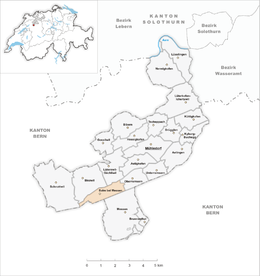Balm bei Messen
| Balm bei Messen | ||
|---|---|---|
| Former municipality of Switzerland | ||

Balm bei Messen village
|
||
|
||
| Coordinates: 47°6′N 7°26′E / 47.100°N 7.433°ECoordinates: 47°6′N 7°26′E / 47.100°N 7.433°E | ||
| Country | Switzerland | |
| Canton | Solothurn | |
| District | Bucheggberg | |
| Area | ||
| • Total | 2.18 km2 (0.84 sq mi) | |
| Elevation | 476 m (1,562 ft) | |
| Population (December 2005) | ||
| • Total | 111 | |
| • Density | 51/km2 (130/sq mi) | |
| Postal code | 3254 | |
| SFOS number | 2443 | |
| Surrounded by | Biezwil, Lüterswil-Gächliwil, Messen, Oberramsern, Ruppoldsried (BE), Schnottwil, Wengi (BE) | |
| Website | SFSO statistics |
|
Balm bei Messen was a municipality in the district of Bucheggberg in the canton of Solothurn in Switzerland. On 1 January 2010 the municipalities of Balm bei Messen, Brunnenthal and Oberramsern merged into the municipality of Messen.
Balm bei Messen is first mentioned in 1254 as de Balmo. In 1275 it was mentioned as in Balm.
Balm bei Messen has an area, as of 2009[update], of 2.18 square kilometers (0.84 sq mi). Of this area, 1.3 km2 (0.50 sq mi) or 59.6% is used for agricultural purposes, while 0.7 km2 (0.27 sq mi) or 32.1% is forested. Of the rest of the land, 0.16 km2 (0.062 sq mi) or 7.3% is settled (buildings or roads).
Of the built up area, housing and buildings made up 4.1% and transportation infrastructure made up 3.2%. Out of the forested land, 30.7% of the total land area is heavily forested and 1.4% is covered with orchards or small clusters of trees. Of the agricultural land, 54.1% is used for growing crops and 5.5% is pastures.
The village is located in the Bucheggberg district, in the Limpach along the southern slope of the Bucheggberg. It consists of the haufendorf village (an irregular, unplanned and quite closely packed village, built around a central square) of Balm bei Messen.
The blazon of the municipal coat of arms is Argent a Holly Branch Vert in bend sinister over a Mount of 3 Coupeaux of the same.
Balm bei Messen has a population (As of December 2005[update]) of 111. Over the last 10 years (1999–2009 ) the population has changed at a rate of 0%.
Most of the population (as of 2000[update]) speaks German (107 or 98.2%), with French being second most common (1 or 0.9%) and Albanian being third (1 or 0.9%).
...
Wikipedia




